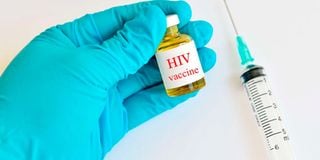Arduous search for HIV vaccine yields new hope

What you need to know:
- While there have been some disappointments, Dr Marianne Mureithi of KAVI-UoN told Healthy Nation that challenges in research do not mean failure. “The HIV trials have not failed, rather, we have learnt a lot from previous trials that have greatly informed us on improving the vaccines and bringing us closer to an efficacious HIV vaccine,” she said.
- The KAVI Institute scientists that Healthy Nation spoke to alluded that an efficacious vaccine for a highly stigmatised disease is the ultimate goal of stopping HIV.
Imagine a world with a Human Immunodeficiency Virus (HIV) vaccine. A world where millions of HIV/AIDS infections are prevented.
Well, imagine no more because scientists are now fast-tracking the development of an efficient HIV vaccine.
While a HIV vaccine may not directly benefit people living with HIV, scientists at the Kenya Aids Vaccine Initiative (KAVI) told Healthy Nation that it will eventually offload the burden on persons requiring lifelong treatment through antiretroviral drugs.
“A world with a HIV vaccine will be healthier to live in,” Prof Omu Anzala, a virologist and a senior clinical researcher working at the KAVI Institute said.
The quest for the HIV vaccine started four decades ago.
When HIV infection in humans was discovered decades ago, there was an avalanche of hope for getting a vaccine stemming from the scientific community.
The search for a vaccine began with the leadership of Margaret Heckler, the then US Secretary of Health and Human Services, who was optimistic that the HIV vaccine would be ready in two years’ time.
But her assistant Edward Brandt, doubted that the vaccine would be available in such a short time.
“Nobody knows for certain how long it will take to develop the vaccine, although the general speculation is that it will be available for clinical testing within two or three years,” he was quoted by American virologist José Esparza in the scientific journal Elsevier.
Turns out Brandt was right because 40 years later, trials and trials of getting a HIV vaccine have been done but none has been successful yet.
“No one knew at the time that HIV/AIDS was much more complex than any other viral disease for which vaccines have been successfully developed,” explained Esparza.
Heckler’s idea was brought to life by French scientists led by Daniel Zagury, who came to Africa in 1987 to conduct the first human trial of a HIV vaccine. The trial was conducted in the same country that some scientists believe is the origin of HIV –the Democratic Republic of Congo (DRC).
Thailand, in 1990, became the first developed country to have in-human HIV vaccine trials, which involved about 2,500 people.
In Kenya, the first clinical trial took place in 2001, and was led by an international consortium including the International Aids Vaccine Initiative (IAVI), University of Oxford, and KAVI-Institute of Clinical Research at the University of Nairobi.
So far, KAVI-UoN has conducted over 18 HIV Vaccine clinical trials and is currently testing three phase I HIV Vaccine trials driving the search for an efficacious HIV vaccine forward.
While there have been some disappointments, Dr Marianne Mureithi of KAVI-UoN told Healthy Nation that challenges in research do not mean failure.
“The HIV trials have not failed, rather, we have learnt a lot from previous trials that have greatly informed us on improving the vaccines and bringing us closer to an efficacious HIV vaccine,” she said.
The KAVI Institute scientists that Healthy Nation spoke to alluded that an efficacious vaccine for a highly stigmatised disease is the ultimate goal of stopping HIV.
However, they acknowledged the long process that it takes to come up with one.
“It begins with basic laboratory research and product development. The next step is candidate vaccines on healthy human volunteers through different phases of clinical trials,” explained Dr Marianne Mureithi, HIV vaccine researcher at KAVI.
Phase I and II trials provide data on the safety of the candidate vaccines and on their ability to induce immune responses specific to HIV.
Depending on the results obtained, candidate vaccines can proceed to large-scale Phase III trials, “to obtain definitive information about their efficacy and offer protection against HIV infection or AIDS.”
Less than a week ago, IAVI and Moderna announced that they would be conducting in-human HIV vaccine clinical trials using a messenger RNA (mRNA) technology.
The study is being conducted in the United States, where 56 HIV negative individuals will be vaccinated. It is the first of its kind.
“Using mRNA for vaccines allows for faster production of vaccine material. With conventional approaches, it can take years to advance a promising idea in the lab into a vaccine candidate that can be evaluated in humans. It can reduce that time from several years to several months,” explained Dr Muturi-Kioi of IAVI, who is based in Kenya.
According to Dr Mureithi, unlike what some people have feared, mRNA does not interfere with genetic makeup. They only carry the instructions for the body to produce the correct proteins, which the immune system sees and makes an immune response against.
“Fairly similar DNA vaccines that also don’t interfere with genetic make-up have been tested over many years and proven to be safe.”
Why then is the HIV virus too complicated?
One problem with HIV lies within its diversity. Every person who is living with HIV has a slightly different virus. And at the global level, the diversity of the virus is enormous.
Previous vaccines have not produced antibodies that can block all existing HIV variants.
“However, we have noticed that some people living with HIV naturally develop special antibodies that block almost all variants of HIV, and those antibodies are called broadly neutralising antibodies (bNABs),” explained Prof Anzala.
Some of the broadly neutralising antibodies have been identified previously at KAVI in collaboration with IAVI. These bNABs have been used as templates for developing vaccines that can induce them using the reverse technology platform. “And this is how the current vaccines are produced.”
Dr Daniel Muema, a postdoctoral research scientist at the KAVI Institute, said the recent announcements alluded to the fact that the world is getting closer to an efficacious HIV vaccine.
“The mRNA technology, and the main goal for vaccines generated using this platform is that they induce broadly neutralising antibodies (bnAbs), which have been shown to prevent HIV infection,” he noted.
While most vaccines like the Covid-19 ones are created to reduce the severity of disease, the goal of a HIV vaccine is to prevent the infection in the first place, Dr Mureithi observed.
“Once you get HIV, it is a lifelong infection and people never fully recover from it, just yet. Covid-19 has had millions of people recovering. We want the vaccine candidates to have components such as bnABs that will neutralise the virus right at the point of entry such as vagina, penis, or the anal canal,” she explained.
Dr Robert Lang’at, a post-doctoral research scientist also at KAVI , said a successful HIV vaccine will definitely change the management of HIV/AIDS.
“Management can be looked at in two ways; prevention and treatment. Having an efficacious HIV vaccine will be a game changer in the prevention of HIV but other multipurpose preventative strategies should still be ongoing to cater for unwanted pregnancies, sexually transmitted infection (STIs) and all,” he said.
Dr Lang’at noted that ARVs production is not likely to be affected should a HIV vaccine be approved for use in humans.
“There is still a large population of HIV infected individuals that will need ARVs; this will go on in tandem with HIV vaccine administration until we get no more people living with HIV,” he said.
Africa has had a number of HIV vaccine clinical trials. Unfortunately, most have not been approved for use for a number of reasons.
Last year, a HIV vaccines study called ‘Imbokodo’ did not sail through as the researchers found out that it could only prevent HIV infection by 25.2 per cent, lower than the required 50 per cent, or more, threshold.
Another large HIV vaccine clinical trial in South Africa dubbed ‘Uhambo’ was also halted because of less efficacy and out of the more than 120 participants who had been vaccinated were infected with HIV.
Preventive measures
Globally, new series of preventive measures, including treatment options, are being touted. In the Paris Declaration Commitments signed in 2014, one of the commitments which have since been met by Kenya was that countries should achieve the 90: 90: 90 target by 2020.
This means that 90 per cent of people living with HIV know their status, 90 per cent of those infected are on antiretroviral treatments, and 90 per cent of those on treatments have reduced their viral load to undetectable levels.
Many countries are yet to meet the goal. However, decades of research on HIV vaccines have taught scientists a lot about the immune system.
“The investment in HIV research has made the response to Covid-19 possible,” said Dan Barouch, director of the Center for Virology and Vaccine Research at Beth Israel Deaconess Medical Center in Boston, whose work on an HIV vaccine has led to one of the leading candidates for a coronavirus vaccine.
According to experts, the two efforts of the viruses are uniting, there is real hope now that researchers are developing and testing an mRNA-based HIV vaccine.
According to the Resource Tracking for HIV Prevention Research and Development Working Group, a project of the advocacy organisation AVAC, about Sh1.6 trillion was spent on HIV vaccine research between 2000 and 2018.
The data shows that so far, there has been five large-scale Phase 3 vaccine efficacy trials against HIV, each at a cost of over US$100 million. The first three of these failed quite convincingly; no protection against acquisition of HIV infection, no lowering of viral loads in those who did become infected. In the third of these trials, the STEP trial, individuals who had been vaccinated were highly infected.
The fourth trial was the controversial Thai RV144 trial, which initially reported a marginal degree of successful protection against the acquisition of HIV infection among vaccinated individuals. However, a subsequent statistical analysis reported that there was less than a 78 per cent chance that the protection against acquisition was real.
A fifth vaccine trial, the HVTN 702, was ordered to confirm and extend the results of the RV144 trial. It was also stopped in the early stages. They found out that there was no protection against acquisition and it did not lower the viral load.
In the data, 46 vaccines have survived to the preclinical or clinical stages of evaluation, and 100 were abandoned earlier in the process, the group’s data shows.
“HIV has a lot of researchers in immunology and virology who set up labs, who have [vaccine] platforms, and they are looking to quickly re-purpose to see if they can find a vaccine,” said Meg Doherty, director of the WHO’s department of global HIV, hepatitis and STI programmes.
Prof Linda-Gail Bekker, deputy director of the Desmond Tutu HIV Centre at the Institute of Infectious Disease and Molecular in Cape Town, South Africa, said HIV vaccine research should have multiple candidates being tried at the same time.
“We are likely to get a vaccine and may be more than just one winner. We are making progress. We must not give up,” Prof Bekker said.





